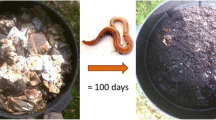Abstract
Trees of the genus Ficus, integral components of indigenous rainfed agro-ecosystems of the southern dry agro-climatic zone of Karnataka, southern India, have traditionally been associated with the ecological service of soil quality enhancement in addition to various direct use benefits. We assessed the soil enrichment service of Ficus benghalensis L. a common Ficus species in these agroforestry systems, by quantifying nutrient return via litter fall. Litterfall estimation and chemical analysis of litter showed that F. benghalensis trees produce 3,512 kg·ha−1 of litter annually which, on decomposition, can satisfy up to 76.70 % of N, 20.24% of P and 67.76% of K requirements of dryland crops annually per hectare. This can lead to an avoided cost of compost of US $ 36.46 ha−1·a−1 in dryland farming systems. The slow rate of decay of Ficus litter, as revealed in litter decomposition studies indicates its potential as ideal mulch for dryland soils. We discuss the complementarity between Ficus litterfall and cropping patterns in Mandya, and its implications for rainfed agricultural systems.
Similar content being viewed by others
References
Anderson JM, Ingram JS. 1993. Tropical Soil Biology and Fertility: A Handbook of Methods (second edition). Wallingford, UK: CAB international, p. 221.
Constantinides M, Fownes JH. 1994. Nitrogen mineralization from leaves and litter of tropical plants: relationship to N, lignin and soluble polyphenol concentrations. Soil Biology and Biochemistry, 26(1): 49–55.
Deb BAR, Arunachalam A, Arunachalam KS. 2009. Ecological analysis of traditional agroforest and tropical forest in the foothills of Indian Eastern Himalaya: Vegetation, soil and microbial biomass. Tropical Ecology, 49(1): 73–79.
Dhanya B. 2011. Integrated study of a Ficus based traditional agroforestry system in Mandya district, Karnataka. Ph. D thesis. Dehradun, India; Forest Research Institute Deemed University, p. 211.
Dhanya B, Viswanath S, Purushothaman S, Suneeta B. 2010. Ficus trees as components of rainfed agrarian systems in Mandya district of Karnataka. My Forest, 46(2): 161–165.
Isaac SR, Nair MA. 2006. Litter dynamics of six multipurpose trees in a homegarden in Southern Kerala, India. Agroforestry Systems, 67: 203–213.
Jackson ML. 1973. Soil Chemical Analysis. New Delhi: Prentice Hall of India Pvt. Ltd., p. 1–125.
Jamaludheen R, Kumar BM. 1999. Litter of multipurpose trees in Kerala, India: Variations in the amount, quality, decay rates and release of nutrients. Forest Ecology and Management, 115: 1–11.
Khiewtam RS, Ramakrishnan PS. 1993. Litter and fine root dynamics of a relict sacred groove forest at Cherrapunji in north eastern India. Forest Ecology and Management, 50: 181–201.
Kumar BM, Deepu JK. 1992. Litter production and decomposition dynamics in moist deciduous forests of the Western Ghats in Peninsular India. Forest Ecology and Management, 50: 181–201.
Mubarak AR, Elbashir AA, Elamin LA, Daldoum DMA, Steffens D, Benckiser G. 2009. Decomposition and nutrient release from litter fall in the semi-arid tropics of Sudan. Communications in Soil Science and Plant Analysis, 39: 2359–2377.
Mugendi DN, Nair PKR. 1997. Predicting the decomposition patterns of tree biomass in tropical highland microregions of Kenya. Agroforestry Systems, 35: 187–201.
Nair MA, Abraham J, John J, Sanjeev V. 1996. Biomass productions and nutrient cycling for sustainability in agroforestry homegardens in Kerala -a case study. In: Proceedings of National Seminar on Organic Farming and Substantial Agriculture. Bangalore: University of Agricultural Sciences, pp 19–20.
Nair PKR. 1993. Introduction to Agroforestry. Dordrecht, The Netherlands: Kluwer, p. 499.
Oglesby KA, Fownes JH. 1992. Effects of chemical composition on nitrogen mineralisation of green manures of seven tropical leguminous trees. Plant and Soil, 143: 127–132.
Palm CA. 1995. Contribution of agroforestry trees to nutrient requirements of intercropped plants. Agroforestry Systems, 30: 105–124.
Parker DT. 1962. Decomposition in the field of buried and surface-applied corn stalk residues. Soil Science Society of America Journal, 26: 559–562.
Pragasan LA, Parthasarathy N. 2005. Litter production in tropical dry evergreen forests of south India in relation to season, plant life forms and physiognomic groups. Current Science, 88(8): 125–126.
Proctor J. 1983. Tropical forest litterfall I. Problems of data comparison. In: S. L Sutton, T. C. Whitmore and A. C. Chadwick (eds), Tropical Rain Forest: Ecology and Management. Oxford, U. K: Blackwell Scientific Publications, pp. 287–309.
Read MD, Kang BT, Wilson GF. 1985. Use of Leucaena leucocephala (Lam.de Wit) leaves as nitrogen source for crop production. Fertility Research, 8: 107–116.
Rowell RM, Pettersen R, Han JS, Rowell J, Tshabalala MA. 2005. Cellwall chemistry: In: R. M. Rowell (ed.), Handbook of Wood Chemistry and Wood Composites. USA: Taylor and Francis, CRC Press, p. 65.
Sadasivam S, Manickam A. 1992. Biochemical Methods for Agricultural Sciences. New Delhi: Wiley Eastern Limited and Coimbatore: Tamil Nadu Agricultural University, p. 246.
Saravanan A, Kalieswari RK, Nambeesan KMR, Sankaralingam P. 1995. Leaf litter accumulation and mineralisation pattern of hilly soils. Madras Agricultural Journal, 82: 184–187.
Semwal RL, Maikhuri RK, Rao KS, Sen KK, Saxena KG. 2005. Leaf litter decomposition and nutrient release pattern of six multipurpose tree species of central Himalaya, India. Biomass and Bioenergy, 24(1): 3–11.
Tanner EVJ, Kapos V. 1992. Nitrogen and phosphorus fertilisation effects on Venezuelan montane forest trunk growth and litterfall. Ecology, 73: 78–86.
Waring RH, Schlesinger WH. 1985. Forest Ecosystem: Concepts and Management. New York: Academic Press, pp. 181–211.
World Agroforestry Centre. 2009. Creating an Evergreen Agriculture in Africa for Food Security and Environmental Resilience. Nairobi, Kenya: World Agroforestry Centre, p. 24.
Young A. 1997. Agroforestry for Soil Management (Second edition). New York, USA: CAB International and Nairobi, Kenya: International Centre for Research in Agroforestry, pp. 47–109.
Author information
Authors and Affiliations
Corresponding author
Additional information
Fund projects: This work is supported by, University Grants Commission, Government of India, New Delhi and Indian Council of Forestry Research and Education, Dehra Dun.
The online version is available at http://www.springerlink.com
Rights and permissions
About this article
Cite this article
Dhanya, B., Viswanath, S. & Purushothaman, S. Does litterfall from native trees support rainfed agriculture? Analysis of Ficus trees in agroforestry systems of southern dry agroclimatic zone of Karnataka, southern India. Journal of Forestry Research 24, 333–338 (2013). https://doi.org/10.1007/s11676-013-0357-6
Received:
Accepted:
Published:
Issue Date:
DOI: https://doi.org/10.1007/s11676-013-0357-6




